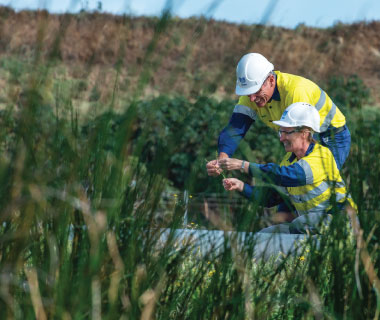Wesfarmers is committed to reducing our relative and absolute greenhouse gas emissions, and all of our business units have initiatives and programs in place to minimise and reduce these emissions.
By measuring reported emissions per million dollars of revenue at the Group level (see figure 5) it is possible to track the changes in our emission intensity over time against the indicator of business performance. Over the past 10 years there have been significant changes in the Group’s business activities, including the acquisition of the Coles Group (in 2007), significant increases in production at our industrial businesses and extensive growth in our retail businesses. These relative metrics are also reported in each business unit section of this report.
In our NGER Act report for 2011/12, Wesfarmers recorded 4,666,196 tonnes carbon dioxide equivalent (CO2e) (Scope 1 and 2 emissions). This is a decrease of 7.49 per cent compared to the 5,044,231 tonnes CO2e reported in the 2010/11 NGER Act report.
This decrease in reported emissions under the NGER Act occurred primarily in WesCEF and Coles (through a mixture of emissions abatement and energy efficiency initiatives) as well as the sale of Premier Coal and enGen.
Figure 6 displays our decrease in NGER Act reported emissions in the four years of reporting under these laws.
In our 2011 NGER Act report, enGen and Premier Coal reported a combined total of 160,836 tonnes CO2e, including 138,231 tonnes CO2e (Scope 1) and 22,605 tonnes (Scope 2). The combined contribution of the businesses we sold during the year, in the period they were owned by Wesfarmers in 2011/12, was approximately 75,666 tonnes CO2e. This includes 64,736 tonnes CO2e (Scope 1) and 10,930 tonnes CO2e (Scope 2). These emissions are reported in the footnotes to the Group data in the Data Bank.
We are also an investor in two joint ventures and a company in Australia which report under the NGER Act: the Bengalla mine in the Hunter Valley, New South Wales (40 per cent-owned by Wesfarmers and operated by Coal and Allied); Queensland Nitrates Pty Ltd at Moura in Queensland (50 per cent‑owned by Wesfarmers and operated as a separate management entity); and the 50 per cent-owned Wespine sawmill in Western Australia.
Our equity share of the 2011/12 emissions reported under the NGER Act by these three businesses is 347,018 tonnes CO2e. The 2011/12 NGER Act reports by these businesses and Wesfarmers will be published in February 2013.
In addition, each year we estimate the greenhouse emissions created from transport operations in our supply chains (calculated as the emissions created in transport from the final supplier to our distribution centre, factory or mine site). In 2011/12, this estimate is 650,925 tonnes CO2e compared to 760,000 tonnes CO2e in 2011. The decrease is primarily related to more accurate measurement of shipping emissions from our maritime transport suppliers.
Our total direct and indirect (Scope 1, 2 and 3) greenhouse emissions for the Group in 2011/12 were 5,820,625 tonnes CO2e. This figure excludes our equity share of joint venture and transport emissions in our supply chain as we have no direct operational control over these activities.
This was 528,951 tonnes CO2e below emissions reported last year on the same basis, largely due to a significant investment across the Group in energy efficiency initiatives, particularly in Coles; emission abatement activity in the chemicals business in WesCEF; and the increasing impact of the mandated Renewable Energy Target on the greenhouse intensity of Australia’s publicly available electricity generation systems.
Further details on several of these initiatives can be found in the relevant business unit sections of this report.
As part of our efforts to reduce emissions, we continue to contribute to a major emissions reduction initiative, the COAL21 fund, which levies coal producers to fund research into low emission coal technologies. To date we have contributed $5.5 million to the COAL21 fund and our total contribution is likely to reach $30 million over 10 years.
From 1 July 2012 a carbon pricing scheme began operating in Australia (under the Clean Energy Act 2011) alongside the similar emissions trading scheme operating in New Zealand.
Wesfarmers is well-prepared for the implementation of these laws, having largely completed a set of complex tasks. This involves emission monitoring and analysis changes in the businesses, review and development of our reporting procedures and policies, and development of carbon accounting policies. It also includes additional auditing and assurance for the Jobs and Competitiveness Program (a program to provide support for trade-exposed and energy intensive businesses) established by the legislation. In preparing for the carbon pricing scheme we are also reviewing the impact on our supply chain and training employees at many levels about the requirements of the Australian Competition and Consumer Commission in respect to potential product price changes related to the new legislation.
This work ensures we can understand and address the compliance requirements of the legislation while ensuring our customers and suppliers are treated fairly.
The carbon pricing legislation in New Zealand continued, although the government has announced its intention to legislate to defer the full carbon price implementation until 2015. Our New Zealand-based greenhouse emissions were 10,332 tonnes CO2e Scope 1 and 2.
NGER Act reports can be found online at www.cleanenergyregulator.gov.au
Further information on our greenhouse emissions can be found in the Data Bank.
